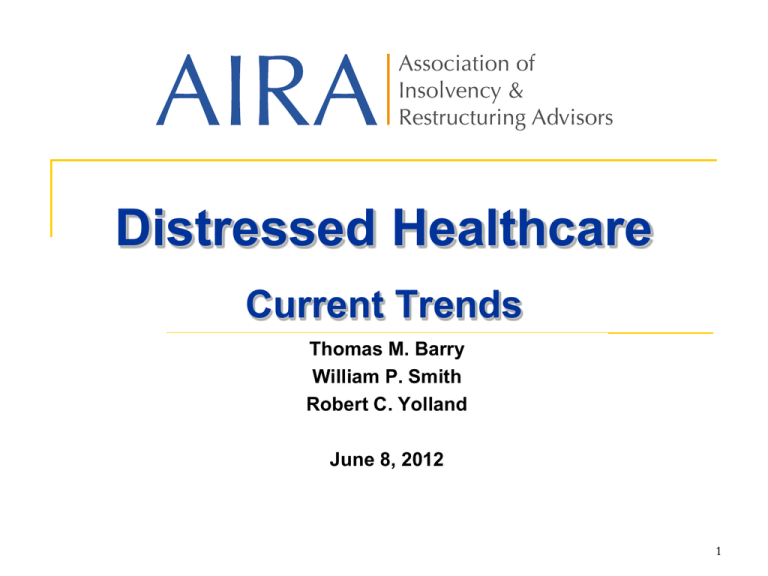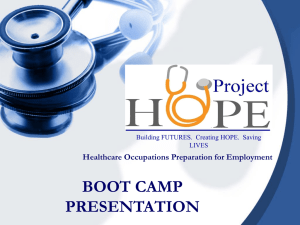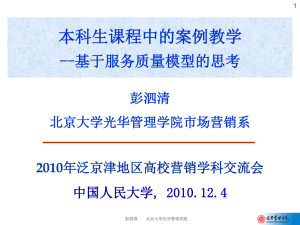
Distressed Healthcare
Current Trends
Thomas M. Barry
William P. Smith
Robert C. Yolland
June 8, 2012
1
Your Players This Morning
Thomas M. Barry – Hammond Hanlon Camp LLC:
an investment banker focusing on healthcare change in control
transactions.
Robert C. Yolland – Franklin Advisors: an institutional
investor focusing on hospitals.
William P. Smith – McDermott Will & Emery LLP: a
lawyer and trailing economic indicator.
2Copyright 2012. All Rights Reserved.
Program
Healthcare Challenges: Last Year and Today.
Current Issues in Healthcare M&A: Realities and
Activity.
Current Issues in Hospital Finance: Front and Back.
Current Issues in Long Term Care: Parable of The
Clare.
Prognosis.
Appendix A: CCRCs As Special Problems
Appendix B: Recent CCRC Bankruptcy Sales
3Copyright 2012. All Rights Reserved.
Biggest Healthcare Stories of 2011
1.
2.
3.
4.
5.
6.
7.
8.
Challenges to Affordable Care Act.
Debt Ceiling Effect on Reimbursement.
Accountable Care Regs. Released.
Payors and Providers Mix It Up.
For Profits Buy.
Tenet-CHS.
Non-profits Buy.
Physician Employment Rises.
4Copyright 2012. All Rights Reserved.
Biggest Healthcare Stories of 2011, cont.
9. Increased Scrutiny of Hospital Tax-Exempt
Status.
10. Fraud Prosecutions Balloon.
Source: Becker’s Hospital Review, 11/06/11
5Copyright 2012. All Rights Reserved.
Biggest Healthcare Stories of 2012 (so far)
Supreme Court Reviews Affordable Care Act.
Aggressive Anti-Trust Review.
Long Term Care Reimbursement.
CCRC Tailspin.
Not So Happy Valley.
Debt Ownership As Leverage Comes to
Healthcare.
6Copyright 2012. All Rights Reserved.
The Realities of Healthcare
Healthcare Investment Banking
HAMMOND HANLON CAMP LLC
h2cllc.com
The Current Model is Fractionated
Current incentives are contributing to unexplained and/or unintended
variation in health care quality and cost
FFS rewards episodic intervention: throughput, ancillary utilization, radical
autonomy and leveraging for rates
Promotes ‘coopetition!’
No “accountability” for patient management:
– Best measurable outcomes
– Referring to the appropriate level of care
– Cost effectiveness
– Coordination of care/team care
– Standardizing around best science
– Team performance
– Patient responsibility
Healthcare Investment Banking
HAMMOND HANLON CAMP LLC
8
We Spend Too Much and Do Not Get Enough in Return
National Healthcare Expenditures per Capita vs. Life Expectancy at Birth(1)
Rest of OECD
U.S.
(1)
OECD Health Data 2011; Dataset includes most recent information available (2008, 2009 and 2010 data)
Healthcare Investment Banking
HAMMOND HANLON CAMP LLC
9
…But it Cannot Last Forever
Cumulative Changes in Health Insurance Premiums, Workers’ Contribution to Premiums,
Inflation and Workers’ Earnings(1) (1999 Index)
(1)
Kaiser/HRET Survey of Employer-Sponsored Health Benefits, 1999-2010; Bureau of Labor Statistics
Healthcare Investment Banking
HAMMOND HANLON CAMP LLC
10
Volumes are Becoming Less and Less Inpatient Centric
Inpatient vs. Outpatient Volume(1) (1990 Index)
(1)
“Trendwatch Chartbook 2011: Trends Affecting Hospitals and Health Systems” American Hospital Association, Avalere
Healthcare Investment Banking
HAMMOND HANLON CAMP LLC
11
Winners and Losers:
The Impact of New Legislation on Two Health Care Organizations
Two Not for Profit Health Care Systems:
One: an old and respected health care provider. Among other activities
operates a long term managed care plan, no debt, large endowment,
profitable
Two: an old and respected health care provider: operates a long term care
facility: no debt, large endowment, profitable
The two serve the same geographic market
New Legislation:
The State in which the two operate is mandating enrollment for “dual
eligibles”
The Impact:
The long term managed care plan will more than double in size,
profitability and value in the next 12 months
The long term care facility plans to be sold since it is concerned it will no
longer be able to deliver its normal brand of quality care
Healthcare Investment Banking
HAMMOND HANLON CAMP LLC
12
Hospital Governance
Many Independent Providers
2,941
2,044
Systems are Evolving
(1)
“Trendwatch Chartbook 2011: Trends Affecting Hospitals and Health Systems” American Hospital Association, Avalere
Healthcare Investment Banking
HAMMOND HANLON CAMP LLC
13
The “Big” Guys are Not Really That Big
The top 10
largest hospital
chains represent
only 6.4% of total
national
healthcare
expenditures
Top 10 Largest U.S. Hospital Systems(1) ($ millions)
Health System
U.S. Veterans Affairs Department
% of Total
Revenue
% of Spend
$50,015
1.9%
HCA
32,506
1.3%
Ascension Health
15,564
0.6%
Community Health Systems
13,626
0.5%
Dignity Health
9,839
0.4%
Catholic Health Initiatives
9,632
0.4%
Tenet Healthcare
9,584
0.4%
Sutter Health
8,777
0.3%
Providence Health & Services
8,082
0.3%
Universal Health Services
7,500
0.3%
Top 10
Hospitals
6.4%
(1) Revenue numbers are for most recent year available
Source: CapitalIQ; Audited Financial Statements
Healthcare Investment Banking
HAMMOND HANLON CAMP LLC
14
How Do We Get There?
Redesign Business Model
Horizontal and Vertical
Integration
Scale
Payors and Providers
Working Together
Consolidation
Healthcare Investment Banking
HAMMOND HANLON CAMP LLC
15
Current vs. Future State of Healthcare
Current State
Future State
Expensive and Inefficient
Achieve Greater Value
Cost Shifting – Pricing Differential
Rate “Normalization” / Revenue
Pressure
Cost and Quality Opaque
Transparent and Consumer Focused
Fee For Service / Utilization Driven
Value Based, Outcomes Driven
Inpatient Centric
Distributed / Outpatient
Fragmented Providers
Consolidated and Integrated
Healthcare Investment Banking
HAMMOND HANLON CAMP LLC
16
And Then a Miracle Happens…
Healthcare Investment Banking
HAMMOND HANLON CAMP LLC
17
So What’s Next?
Payors
Physicians
Data & Information
Underwriting Capability
Coordinate &
Deliver Care
Hospitals
Care Delivery - Infrastructure
Capital
Integrated Delivery System With Scope and Scale
Healthcare Investment Banking
HAMMOND HANLON CAMP LLC
18
The New Model for Survival
The emerging success model will require transformational change and
impose new risks on hospitals. Successful hospitals and health systems will
need to possess or develop:
– An “essential” market position and growth strategies to drive revenues
and achieve critical mass
– Integrated physicians to support quality and cost initiatives
– Ability to demonstrate value proposition to employers and payors measurable quality and cost effectiveness
– Alignment with other providers to enable patients to be managed
seamlessly across multiple care sites
– Sophisticated IT and care management infrastructures
– Access to capital to fund overdue and increasing capital expenditure
requirements
– Medical technology and telemedicine
– Effective management and governance
Healthcare Investment Banking
HAMMOND HANLON CAMP LLC
19
Partnership and Consolidation Activity
Healthcare Investment Banking
HAMMOND HANLON CAMP LLC
20
M&A Activity
Announced Hospital and Health System Transactions
M&A activity was
high in the late
90s, and is rising
again today, as
the current
healthcare model
takes its toll on
profitability and
margins
Relatively High Margins /
Minimal Legislation
Distributions of Transactions by Ownership Model
1995
2000
27%
28%
2011
15%
22%
36%
51%
14%
12%
65%
3%
7%
31%
NFP-NFP
8%
55%
20%
7%
2012
FP-FP
NFP-FP
FP-NFP
Source: Irving Levin Associates, Inc. and H2C
Healthcare Investment Banking
HAMMOND HANLON CAMP LLC
21
Recent M&A Activity: Publicly Traded For-Profit Acquirers
Acquirer
Target
Strategic Rationale
(Rejected)
Scale
New Market
Value Asset
Scale
Expansion
Consolidate
Industry
Scale
Demographics
Geographic
Expansion
Scale
In-Market
Specialization
Scale
New Market
Value Asset
Geographic
Expansion
Specialization
Branding
Strategy
Consolidation
Service Line
Expansion
Scale
New Market
Value Asset
Healthcare Investment Banking
HAMMOND HANLON CAMP LLC
22
Analysis of Recent Transactions: Trends
Need for scale and market strength driving activity
– Weak market and financial positions driving independent hospitals to
find partners
– National multi-hospital systems with single facilities in unfavorable
markets facing need to prioritize
• Significant activity among Catholic systems, including facility “swaps”
– Strong regional systems acquiring independent hospitals to improve
market position
– For-profit hospital management companies – both publicly-traded and
privately held – are extremely acquisitive
Healthcare Investment Banking
HAMMOND HANLON CAMP LLC
23
Analysis of Recent Transactions: Trends
Substantial capital looking for investment opportunities in the healthcare
sector
– New private-equity backed hospital management companies formed to
pursue acquisitions and / or joint ventures, many with a focus on not-forprofit facilities
– Increased funding for those already operational
Non-cash mergers have become the primary transaction structure utilized
by not-for-profits
– Financially sound hospitals facing substantial capital requirements and
reduced access to capital
– Governing boards’ preference to retain not-for-profit status
– Governance rights and capital commitments in lieu of cash
– Regional systems merging to create super-regionals
Healthcare Investment Banking
HAMMOND HANLON CAMP LLC
24
Hospital Finance: Investor Concerns
ACA makes Future Reimbursement Difficult.
Medicare Under Pressure – 2024 Is Not Far.
States Are Struggling Affecting Medicaid.
Falling Utilization.
Little to No Revenue Growth.
Physician Acquisitions – Movie Wasn’t That
Great the Last Time.
Strong Getting Stronger; Weak Weaker.
25Copyright 2012. All Rights Reserved.
Hospital Finance: Investor Concerns, cont.
Ratings Compression: Single Site Close to
Multi-Hospital Systems.
Pension Expenses.
Swap Issues.
Yield Compression.
Direct Placements Return to Hospitals.
Supply Leads to Weakening of Legal
Structures.
26Copyright 2012. All Rights Reserved.
Hospital Finance: Back End
Search for Capital Partners:
PE Rides to the Rescue:
St. Vincent’s I & II
West Penn - Highmark
Vanguard – Detroit Medical Center
Cerberus – Caritas Christi create Stewart
Bayonne; Hoboken; Christ
Regulators Rule: Cheboygan & Peninsula.
Default As Leverage To Augment Structure.
27Copyright 2012. All Rights Reserved.
Senior Living: Parable of The Clare
28Copyright 2012. All Rights Reserved.
CCRC Endowment Structures
Typically a partially refundable payment at
entrance, combined with monthly service
fees.
Continuum of Care.
Early Sales Pay Down Early Maturities.
Rise in Unit Values Repay Long Term Debt.
Little to No Equity From Sponsor.
Often “Mission Driven” Non-Profit Sponsor.
29Copyright 2012. All Rights Reserved.
5/31/2009
3/31/2009
1/31/2009
11/30/2008
9/30/2008
7/31/2008
5/31/2008
3/31/2008
1/31/2008
11/30/2007
9/30/2007
7/31/2007
5/31/2007
3/31/2007
1/31/2007
11/30/2006
9/30/2006
7/31/2006
5/31/2006
3/31/2006
Fully Refundable Presales – Aren’t
Clare "pre-sale" (aka: fully refundable deposit) rate
100.0%
90.0%
80.0%
70.0%
60.0%
50.0%
40.0%
30.0%
20.0%
10.0%
0.0%
30Copyright 2012. All Rights Reserved.
Result
Occupancy Freezes at 31%.
Arguments Over Entrance Endowments.
Exposes Cracks Among Lenders.
Working Capital Evaporates.
Regulators “Concerned”.
Publicity Does Not Augment Marketing.
31Copyright 2012. All Rights Reserved.
Intermediate Solutions
2010: Exchange Offer Gives Equity Fix:
Fixed Convert to A/B Structure
Variable Agree to Convert When L/C Expires
Effect Is Equity Fix and Covenant Relief
Lasted Seven Months
2011: Covenant Relief:
Loosen Strictures; Add Working Capital
Lasted Four Months
32Copyright 2012. All Rights Reserved.
Final Solution
Chapter 11 on November 15, 2011.
Sale Held April 12, 2012.
Plan Confirmed April 27, 2012.
Recovery: 21% for Debt; 100% for Residents;
Zero for Trade and Sponsors.
Concessions by Landlord.
Strategic PE Buyer.
Repeated In Multiple Jurisdictions.
Big CCRCs Still Struggling.
33Copyright 2012. All Rights Reserved.
CCRC Results To Date
A never-ending string of amendments (and
fees) for the “healthy”.
Some Refinancing with Fixed Debt.
Hope and Schmuck Notes Abound.
363 Sales to Distressed PE Buyers.
Little Creativity.
Lender Revolt Brewing Relative to Resident
Recoveries.
34Copyright 2012. All Rights Reserved.
Prognosis:
Mission Focus: Do You Want to Be In This
Business?
If You Mark It Down, They Will Buy.
PE Has the Dough; Does It Have the Exit?
Given Time, Non-profits Will Play.
Litigation Seems More Likely Than Recent
Past.
He Who Has The Gold, Rules.
35Copyright 2012. All Rights Reserved.
APPENDIX A:
Why Are CCRCs Special Problems?
CCRCs are being affected by several forces:
-falling personal net worth;
-dislocation in housing markets; and
-contraction in commercial debt markets.
Results:
-slower fill-up, lower occupancy rates, maturity date
structural
-roadblocks, covenant violations;
-increasing yield spreads;
-shorter letter of credit terms given lenders’ balance sheets;
and
-inability to arrange refinancing or purchase money
financing.
36Copyright 2012. All Rights Reserved.
Conventional Financing
Market dominated by a small number of lenders.
Unique underwriting set.
Construction financing generally tied to entrance deposit
collateral (phased to hedge risk); take out financing tied to fill up.
Current environment is gloomy:
Many lenders out of market, period!
Many with workouts, causing internal strain.
Appetite for new credit support or refinancing limited and, if
available, only with higher spreads.
“Integrated” legal structure makes use of government financing
for a “piecemeal” approach to access more available credit (i.e.
carve out SNF, AL, unit) difficult to achieve.
37Copyright 2012. All Rights Reserved.
Bond Financing
Favorable pricing continues to be attractive.
Ability to tie construction risk with lease up risk with long term
operating risk unique, especially at fixed rates!
History of tax-exempt CCRC financing lead to current favored
structure of short term letter of credit backed variable rate debt
and long term fixed rate debt.
However, shared collateral pledges and different aspirational
goals lead to tension between variable and fixed interests.
Use of 100% debt financing leads to early stress if thinly
capitalized or unmotivated sponsor.
Nature of publically traded debt leads to challenges in altering
structure.
Advent of distressed debt buyers a new and untested
phenomenon.
38Copyright 2012. All Rights Reserved.
Governing Law
No comprehensive federal law on CCRCs
State regulated:
Jurisdiction-specific
Certain jurisdictions have more comprehensive laws in
effect (e.g., CA, FL, NC, NY and PA)
Areas typically covered:
Entry Requirements
Financial Solvency
Consumer protection
Residents’ rights
Health & Safety Requirements
39Copyright 2012. All Rights Reserved.
Regulatory Authorities
* “CCRCs offer multiple levels of health and long-term care
services, [therefore] regulatory gaps and overlaps exist.”
* “Coordination of these various authorities is a
persistent problem in most states.”
State Department of Insurance
State Health Department; State Office on Aging; State Social Services
Department
State Attorney General’s Office
Statewide CCRC Advisory Boards/Councils
State Long Term Care Ombudsman
*Elder Law Portfolio Series, Portfolio No. 5, Housing Options, Release #11, 5-29 (Stephanie Edelstein ed., 1999).
40Copyright 2012. All Rights Reserved.
Examples of State Laws
Massachusetts: Mass. Gen. Laws ch. 93 § 76
Florida: Fl. Stat. Ann. § 651
Office of Elder Affairs mandates disclosure:
Facility files Disclosure Statement containing: organizational
and management information; business experience; financial
statements; fees; services; and copy of residents’ rights.
Dept. of Financial Services, Office of Insurance Regulation is
the principal regulator:
Statutory minimum liquid reserve requirement
California: Cal. H & S Code §§ 1770-1793
Dept. of Social Services, Continuing Care Contracts Branch
regularly evaluates financial stability and mandates reserve
levels
Statewide Continuing Care Advisory Committee
41Copyright 2012. All Rights Reserved.
Stakeholders in Distressed CCRC
Sponsor and Shareholders.
Manager and Required Consultants.
Residents (and their progeny in a life care return
of capital model!)
State (attorney general and regulatory
authorities).
Institutional creditors (bondholders, trustees,
letter of credit issuer, insurer).
Trade debt.
Local community (watch out if your alternative
use requires a zoning change!)
42Copyright 2012. All Rights Reserved.
Identifying Source of Problem
1.
2.
3.
4.
Operational – Cost overruns, occupancy, service delivery,
reputational, and reimbursement issues.
Market – Demand side, condition (capital expenditures?),
supply side.
Finance – Maturity date, amortization, rate increases on
variable rate debt; investment losses on endowment
funds; covenant (occupancy; marketing; coverage)
breaches; the cost of consultants, both in cash and
management distraction.
Management/Sponsor Attention – Single site versus
multi-site; commingling of cash; dilution of time.
43Copyright 2012. All Rights Reserved.
Solutions
Operational
1.
Expense control (vendors; staffing).
Capital expenditures and use of endowment.
Management change, component management change, or consultant
change.
Rebranding.
Observation rights.
Market
2.
Use of endowment (compare interest vs. principal).
Receiver’s involvement without bankruptcy.
Unit pricing.
Seller unit financing or spread payments over twelve to eighteen mos.
Closure or conversion of units.
Rental versus ownership.
44Copyright 2012. All Rights Reserved.
Solutions, continued
Finance
3.
Debt exchange (but cancellation of indebtedness income).
Debt restructure by forbearance.
Covenant or loan terms relief and conditions.
Bifurcation of debt structure.
Equity infusion (manager; joint venture partner).
Additional collateral, sponsor guaranty.
Subdivision of facility (unbundling SNF or AL).
Sale, foreclosure, deed in lieu.
Bankruptcy: 363, prepacks, and plans.
45Copyright 2012. All Rights Reserved.
Solutions, continued
Management/Sponsor Attention:
4.
Distraction, loss of focus, home office syndrome;
Wider skill set and advisor skill set may be needed;
In multi-site operations, commingling of cash can be a
likely result with difficult ramifications.
Piecemeal nature of separately financed facilities tied by
common ownership or management leads to tension
among stakeholders of the sponsor or parent
organization.
Sponsor organization may have different agenda, whether
preserving equity for shareholders, legacy for charismatic
participants, or mission.
46Copyright 2012. All Rights Reserved.
Solutions, continued
On Private Equity side, significant control
rights (elect board, veto sales, replace
officers) gives faster response, but lenders
have been reluctant to use these techniques.
Lender observation rights, ability to approve
new manager or require officer with specific
skill set may be useful alternative.
47Copyright 2012. All Rights Reserved.
Barriers/Alternatives
Operational
1.
Revenue Increases:
Non-Core Service Curtailment:
State CCRC laws (CA/FL) require advance notice to residents, resident
participation in budgeting (CA) and detailed reasoning if over CPI.
Changes to residency service agreements require advance notice and/or approval
by regulators (CA/FL).
Staffing bed reductions; (Note: certain states (e.g. FL) require approval to
reduce, redeploy SNF beds to IL or “community based” SNF beds; FL has
a 1:4 ratio).
Use of endowment; escrows for operations. Note – Many states require
that twelve months of debt service reserves or 10% of annual operating
expenses be maintained (some allow “credit” under loan or trust
agreements) and that these and entrance fee escrows be lien free.
48Copyright 2012. All Rights Reserved.
Barriers/Alternatives, continued
2.
Management Change; Some states require notice,
approval of any change in management, “structure”,
“substantial” change of control; ability to revoke Certificate
of Authority based on solvency review.
Market
Contractual limitations on repricing of units.
Conversion to rental (Note: CA requires disclosure and
approval of conversion of units originally designated
entrance fee to rental model).
49Copyright 2012. All Rights Reserved.
Barriers/Alternatives, continued
3.
Finance
Bondholder consent provisions.
Bank syndicate consent provisions; differences in creditor
objectives and perspectives.
Caution: Many state CCRC laws require advance notice (CA;
FL) and in some cases approval (CA) of any transaction,
refinancing transaction or one where the regulators believe
reserves are jeopardized or fees may increase.
Health Regulator or Insurance Commissioner or Attorney
General restrictions or conditions on collateral foreclosure are
prevalent.
Restrictions on use of escrows or endowments for operational
collateral (Note: Specific state law restrictions on crosscollateralization – e.g. PA).
Cancellation of indebtedness income an unwelcome effect.
Subdivision of property causes real estate and regulatory issues
50Copyright 2012. All Rights Reserved.
Barriers/Alternatives, continued
4.
Management/Sponsor Attention:
Management Replacements, both local and home office.
Management Replacements, both in whole and in part.
Consultants: to assist and to police.
Cash control: for fun and collateral differentiation.
Consultant control: when dueling and when interfering.
Consultant compromise: maintaining independence while
cooperating.
Getting to the Board: is there intelligent life apparent?
Multiple layers of stakeholders: my borrower’s parent’s creditors
are not my
friend.
51Copyright 2012. All Rights Reserved.
Appendix B – CCRC Bankruptcy Sales and
Recoveries (last 24 months; in millions)
Clare Oaks: IL $95.5; sale pending.
St. Mary: OH $46; sold for $18.8.
Clare: IL $229; sold for $53.5.
Fairview Village: IL $56.8; sold for $28.75.
Monarch Landing: IL $14; sold for $10.
Sedgebrook: IL $14.3; sold for $10.
Villa San Antonio: TX $36; sold for $15.
Villages at Penn State: PA $34.6; sold for $18.5.
Erickson: TX 20 communities sold for $365M.
52Copyright 2012. All Rights Reserved.







